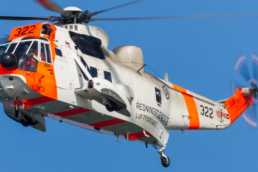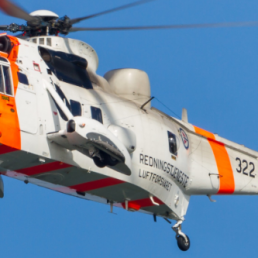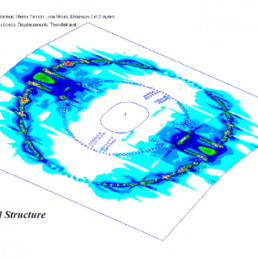Task Objectives - Sea King Mid Life Upgrade
Airframe Designs was engaged by Tenencia Aerospace Design to assist with the design, development, and certification of a Mid-Life Upgrade for a fleet of Westland WS-61 Sea King helicopters.
The primary element of the upgrade involved the integration of a replacement radar scanner mounted on the top of the centre fuselage. The upgrade also covered the introduction of various avionic upgrades requiring several new antennas.
The objective was to certify the upgrades to demonstrate compliance per an elected civilian certification basis of FAR-29 Amendment 47 with the exception of fatigue, for which compliance per CAR-7 regulation 7.251 was accomplished. The compliance demonstration was to be reviewed and approved by a foreign Military Authority.
Finite Element Modelling
For the radar scanner installation, the new scanner was heavier than the original and this necessitated some wide-ranging structural reinforcements to ensure that the stress levels in the principal structural elements remained within original limits.
A pre- and post-modification Finite Element Model was prepared in NASTRAN to examine and compare stress levels to demonstrate that the post-mod design was acceptable.
Static Analysis
For existing primary structure, the static analysis approach simply ensured that post-modification stresses remained within original levels observed for the pre-modification situation.
For new parts and fasteners, it was necessary to check the static strength by comparing ultimate and limit applied stresses/loads with ultimate and yield allowables. Buckling and crippling checks were also carried out for any structure experiencing compressive or shear loading.
Vibration Assessment
Vibration was initially assessed using MSC NASTRAN solution sequence 103 to estimate natural frequencies of the pre- and post-modified structure.
The natural frequencies were then compared to ensure that the new installation did not deviate significantly from the original design and to also inform the customer of the new design frequencies in relation to the helicopter rotor blade passing harmonics.
AFD also supported initial ground and flight testing to mitigate any risk of adverse vibration response in relation to the design change.
Fatigue Assessment
The structural changes introduced by this upgrade had no significant impact on load paths and caused no significant deviation from the original airframe stress levels.
The design changes respected Structural Repair Manual (SRM) principles to ensure adequate edge margins, fastener pitches, section changes, and appropriate material /fastener selection.
As such it was not necessary to perform any kind of detailed fatigue analysis and compliance was demonstrated through statement.
Testimonial
(Paul Johnson – Managing Director)
“The upgrade to the Sea King fleet was very challenging with a high level of scrutiny from the Military Authority. Installing a radar scanner that was heavier than anything ever installed previously posed significant challenges to the stress team but through close cooperation with Tenencia design engineers a workable solution evolved that was ultimately accepted by the customer. AFD has supported Tenencia for more than a decade, providing a highly effective offering for all of our structural certification needs across aircraft and rotorcraft”.





